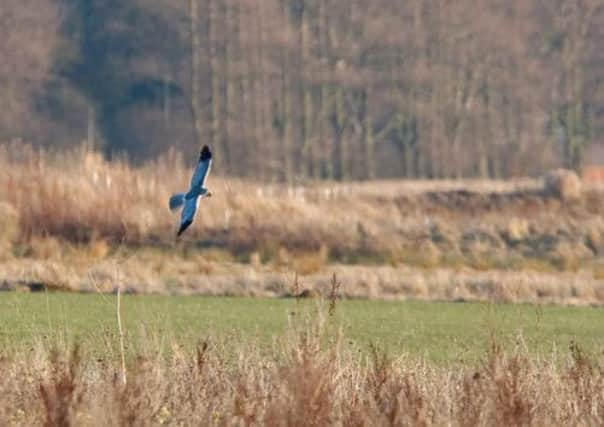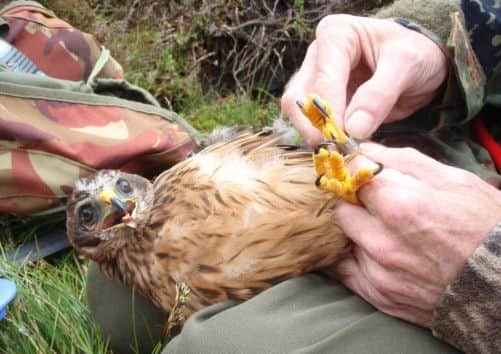Harried and persecuted, birds of prey are still in firing line across the region


“It’s pretty shocking that we’re actually having this discussion,” says Bob Elliot, head of investigations at the RSPB. “That we’ve got amazing birds such as the hen harrier and yet we’re at real risk of losing them from the uplands of northern England is both remarkable and saddening.”
These comments come soon after Yorkshire, and in particular the north of the county, was named by the conservation charity as a “black spot” for Britain’s birds of prey, with several species being deliberately targeted for persecution.
Advertisement
Hide AdAdvertisement
Hide Ad“Let’s be clear,” Elliot points out. “There have been some remarkable success stories in Yorkshire. I’m thrilled that I can now see red kites flying around West Yorkshire, where I grew up, and buzzards have also enjoyed a remarkable turnaround over recent years. And yet, there are still problem black holes in certain parts of the UK, and that includes parts Scotland and parts of Yorkshire.”


Of particular concern are the uplands of North Yorkshire, home to several estates managed for grouse shooting.
“This amazing landscape is ideal for hen harriers, and yet we only have one breeding pair here. The fact of the matter is, they’re being ‘taken out’,” Elliot argues, pointing to the case of Bowland Betty, a solitary female hen harrier found dead on the moors in June last year.
A post-mortem analysis of the bird’s body, carried out at the Zoological Society of London (ZSL) and University College London confirmed the hen harrier, one of only 10 breeding pairs in England, had died from a fractured leg, containing a fragment of lead shot, with the blame laid firmly at the door of gamekeepers keen to safeguard their grouse.
Advertisement
Hide AdAdvertisement
Hide AdA £1,000 reward was offered for information leading to the conviction of those responsible for the death of the bird on Thorny Grain Moor, which was part of a major conservation project.
At the same time, bird of prey persecution remains a problem in the lowlands of the county, with goshawk, peregrine falcon, buzzard and red kite all being targeted, often by gamekeepers working to protect pheasant populations.
In February of this year, a North Yorkshire gamekeeper was convicted in a Scarborough court of using baited cages to trap a buzzard, with police believing the traps were actually being used to trap goshawks.
Also over the past couple of years, a poisoned buzzard has been found in Ripon, another was shot in Sheffield and a poisoned peregrine found in Rishworth, in the west of the county, with such cases likely to be just the tip of the iceberg.
Advertisement
Hide AdAdvertisement
Hide Ad“It’s incredibly difficult to say how many birds of prey are being killed,” says Ellis.
“Most of the incidents we investigate have been discovered by chance by members of the public so it’s hard to say whether numbers are going up or down. But, let’s be clear; even one raptor death is too many.”
Understandably, gamekeepers associations and shooting organisations take umbrage with the assertion that it is their members who are responsible for Yorkshire being named as the worst place in the whole of the UK for bird of prey persecution.
For starters, the Moorland Association points out, not only have cases of birds being illegally killed dropping over the past few years, but gamekeepers are nothing like the malevolent force they are often painted as being.
Advertisement
Hide AdAdvertisement
Hide Ad“Of the 42 individuals prosecuted in the courts in 2011, just seven were either full or part-time gamekeepers and of the offences for which they were found guilty, only two were directly linked to the taking or death of a bird of prey,” says a spokesman for the organisation.
Moreover, says Alasdair Mitchell, regional director of the British Association for Shooting and Conservation (BASC) in the north of England, those gamekeepers who do trap, poison or shoot birds of prey – something which is illegal under the Wildlife and Countryside Act anyway – have no place in the profession.
“Unfortunately, a handful – and it literally is a handful – of gamekeepers take matters into the own hands and break the law. Often they may be exasperated and tired of seeing their hard work, that is the birds they have been rearing, destroyed,” he says. “At the BASC, we think that bird of prey persecution blackens the name of the shooting community.
“We are totally opposed to it; if any of our members are found to have gone down this route – and, in the vast majority of cases, gamekeepers that are prosecuted are not members of our organisation – then they will be kicked out, no ifs, no buts.”
Advertisement
Hide AdAdvertisement
Hide AdFor Mitchell, far from being seen as the problem, the gamekeeping and shooting community should be seen as part of the solution.
“The shooting community has an important role to play in conservation,” he says. “Look at Harewood House [in West Yorkshire]. There, gamekeepers were instrumental in the reintroduction of red kites in northern England.”
Bob Elliot at the RSPB agrees. “Absolutely,” he says. “Gamekeepers and shooters can be part of the solution, and rightly so. In fact, at the end of the day, it’s up to them; they’re on the ground and they can make a real difference.”
So, despite acknowledging that there are indeed “certain hotspots where problems do occur,” Mitchell maintains that a healthy pheasant and grouse shooting economy can coexist alongside healthy raptor populations, with gamekeepers across Yorkshire currently taking the lead on this, with deterrence rather than persecution the key.
Advertisement
Hide AdAdvertisement
Hide AdFor instance, gamekeepers are proactively working to ensure there are no potential perches, natural or otherwise, located close to grouse or pheasants, while some estates, including Ripley Castle are trialling live bait deterrents such as releasing rodents along the edges of shooting land in order to distract would-be predators.
While the shooting community may well be taking the initiative, Elliot is still keen to see the Government do more to ensure birds of prey are afforded better protection.
For him, the potential introduction of the concept of “vicarious liability” into England and Wales could play a key role in helping raptor populations grow.
Should Westminster follow the lead of Scotland – with the Environment Audit Committee meeting this week to discuss possible changes to the Wildlife and Countryside Act – then landowners will be held legally responsible for and wildlife crimes that occur on their estates, rather than just individual gamekeepers being prosecuted.
Advertisement
Hide AdAdvertisement
Hide Ad“Though it’s still early days, we’ve seen a drop in bird poisoning cases across Scotland since vicarious liability was brought in,” says Elliot. “So this suggests it could have a positive impact in Yorkshire and the rest of England as well.”
Whether it’s through the shooting community taking the initiative or through the introduction of tougher legislation, conservationists are confident that should birds of prey be left in peace, their numbers will soon increase, significantly enhancing the biodiversity of Yorkshire.
“It’s not like golden eagles, who need years to start thriving. If the pressure’s off, hen harriers can bounce back pretty quickly; we could see a major turnaround in just a few years,” adds Elliot. “I, for one, can’t wait for the day when such magnificent animals can be seen flying over Yorkshire in healthy numbers.”
Hen Harriers targeted
When the RSPB was founded in 1889, birds of prey were systematically persecuted. By the early 1900s, five of 15 native species had been exterminated.
Advertisement
Hide AdAdvertisement
Hide AdIt became illegal to kill birds of prey more than 50 years ago and since then their numbers have recovered and red kites and white tailed eagles have been successfully reintroduced to Britain.
However, since 2006, 2,578 incidents involving or targeting wild birds of prey have been reported to the RSPB and the hen harrier population has been particularly affected. Last year, just one pair bred successfully in England. In Scotland it has been estimated the numbers would increase by 13 per cent each year if illegal killing was stopped.